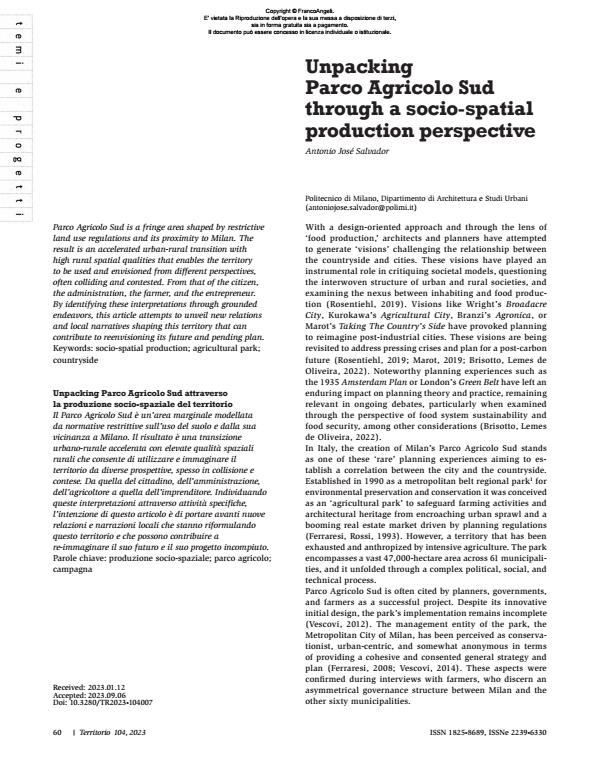Unpacking Parco Agricolo Sud attraverso la produzione socio-spaziale del territorio
Journal title TERRITORIO
Author/s Antonio José Salvador
Publishing Year 2024 Issue 2023/104 Language English
Pages 7 P. 60-66 File size 519 KB
DOI 10.3280/TR2023-104007
DOI is like a bar code for intellectual property: to have more infomation
click here
Below, you can see the article first page
If you want to buy this article in PDF format, you can do it, following the instructions to buy download credits

FrancoAngeli is member of Publishers International Linking Association, Inc (PILA), a not-for-profit association which run the CrossRef service enabling links to and from online scholarly content.
Parco Agricolo Sud is a fringe area shaped by restrictive land use regulations and its proximity to Milan. The result is an accelerated urban-rural transition with high rural spatial qualities that enables the territory to be used and envisioned from different perspectives, often colliding and contested. From that of the citizen, the administration, the farmer, and the entrepreneur. By identifying these interpretations through grounded endeavors, this article attempts to unveil new relations and local narratives shaping this territory that can contribute to reenvisioning its future and pending plan.
Keywords: socio-spatial production; agricultural park; countryside
- Andersson K., Eklund E., Lehtola M., Salmi P., 2009, Beyond the rural-ur- ban divide: cross-continental perspectives on the differentiated coun- tryside and its regulation. Croydon: The Emerald Group Publishing.
- Brisotto C., Lemes de Oliveira F., 2022, eds., Reimagining Resilient Productive Landscapes. Cities and Nature. Cham: Springer. DOI: 10.1007/978-3-030-90445-6_1
- Donadieu P., Mininni M., 2006, Abitare il territorio e costruire paesaggi. In Campagne Urbane. Una nuova proposta di paesaggio della città. Roma: Donzelli.
- Ferraresi G., 2008, «‘Nutrire il pianeta, energia per la vita’ a partire da Mi- lano e territorio». Territorio, 46: 135-138. DOI: 10.3280/TR2008-046023.
- Ferraresi G., Rossi A., 1993, a cura di, Il parco come cura e coltura del territorio. Un percorso di ricerca sull’ipotesi del parco agricolo. Brescia: Grafo.
- Gallent N., 2006, «The Rural–Urban fringe: A new priority for plan- ning policy?». Planning. Practice & Research, 21, 3: 383-393. DOI: 10.1080/02697450601090872
- Halfacree K., 2007, «Trial by space for a ‘radical rural’: Introducing alter- native localities, representations and lives». Journal of Rural Studies, 23, 2: 125-141.
- Lapenna A., 2019, «Ecosistemi urbani, spazi fessura e dispositivi in- termilieux». Atti della XXII Conferenza Nazionale SIU, L’Urbanistica italiana di fronte all’Agenda 2030. Portare territori e comunità sulla strada della sostenibilità e della resilienza, Matera-Bari, 6-8 giugno 2019. Roma-Milano: Planum Publisher, 389-393.
- Lowe P., Marsden T., Murdoch J., Ward N., 2003. The Differentiated Countryside. London: Routledge. DOI: 10.4324/9780203986530
- Magnaghi A., 2000, Il progetto locale. Torino: Bollati Boringhieri. Marot S., 2019, Taking The Country’s Side, Agriculture and Architecture. Lisbon Architecture Triennale. https://agriculture-architecture.net/ compass (access: 2023.08.25).
- Marsden T., 1999, «Rural Futures: The Consumption Countryside and Its Regulation». Sociologia Ruralis, 39, 4: 501–526. DOI: 10.1111/1467-9523.00121
- Rosentiehl A., 2019, Capital Agricole: chantiers pour une ville cultivée. Paris: Èditions du Pavillon de l’Arsenal.
- Sabate J., 2015, «Reflexiones en torno al proyecto urbanístico del Par- que Agrario». In: Yacaman C., Zazo A. (eds.), El Parque Agrario: una figura de transición hacia nuevos modelos de gobernanza territorial y alimentaria. Madrid: Heliconia, 93-111.
- Schwarz A., Streule M., 2016, «A Transposition of Territory: Decoloni- zed Perspectives in Current Urban Research». International Journal of Urban and Regional Research, 40: 1000-1016. DOI: 10.1111/1468-2427.12439
- Tornaghi C., Dehaene M., 2020, «The prefigurative power of urban politi- cal agroecology: rethinking the urbanisms of agroecological transitions for food system transformation». Agroecology and Sustainable Food Systems, 44, 5: 594-610. DOI: 10.1080/21683565.2019.1680593
- Vescovi F., 2012, Proposte per il Parco Agricolo Sud Milano. Criticità e risorse dell’agricoltura periurbana. Cremona: Ronca.
- Vescovi F., 2014, «Parco Agricolo Sud ed Expo 2015: per una nuova go- vernance dell’agricoltura periurbana milanese». Territorio, 70: 92-100. DOI: 10.3280/TR2017-070016
Antonio José Salvador, Unpacking Parco Agricolo Sud through a socio-spatial production perspective in "TERRITORIO" 104/2023, pp 60-66, DOI: 10.3280/TR2023-104007